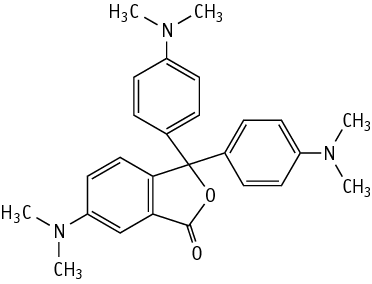

Oral toxicity of 3,3-bis(p-dimethylaminophenyl)-6-dimethylaminophthalide was studied in rats in a 28-day repeated dose toxicity test at dose levels of 0, 8, 30, 120, and 500 mg/kg. On histopathological examination, diffuse hypertrophy of follicular cells in the thyroid was apparent in both sexes receiving 500 mg/kg, along with hypertrophy of chief cells in the parathyroid and hepatocytes in the liver in males. These changes disappeared during the recovery period. There were no abnormalities in body weights, food consumption, hematology, blood chemistry, urinalysis or organ weights. The NOEL is considered to be 120 mg/kg/day for males and females from this study.
Genotoxicity of 3,3-bis(p-dimethylaminophenyl)-6-dimethylaminophthalide was studied by a reverse mutation test in bacteria. The substance was not mutagenic in Salmonella typhimurium TA100, TA1535, TA98, TA1537 or Escherichia coli WP2 uvrA, with or without an exogenous metabolic activation system.
Genotoxicity of 3,3-bis(p-dimethylaminophenyl)-6-dimethylaminophthalide was studied by the chromosomal aberration test in cultured Chinese hamster lung (CHL/IU) cells.
3,3-Bis(p-dimethylaminophenyl)-6-dimethylaminophthalide did not induce structural chromosomal aberrations or polyploidy up to 4.2 mg/mL (10 mmol/mL) under the present test conditions.
| Purity | : | 99.5 % |
| Test species/strain | : | Rat/Crj:CD(SD)IGS |
| Test method | : | OECD Test Guideline 401 |
| Route | : | Oral (gavage) |
| Dosage | : | 0 (vehicle), 2000 mg/kg |
| Number of animals/group | : | Males, 5; females, 5 |
| Vehicle | : | 0.5 % Sodium carboxymethylcellulose mixed with 0.1 % Tween 80 |
| GLP | : | Yes |
Test results:
The LD50 value is considered to be more than 2000 mg/kg for both sexes.
| Purity | : | 99.5 % |
| Test species/strain | : | Rat/Crj:CD(SD)IGS |
| Test method | : | Guideline for the 28-Day Repeated Dose Toxicity Test in Mammalian Species (Chemical Substances Control Law of Japan) |
| Route | : | Oral (gavage) |
| Dosage | : | 0 (vehicle), 8, 30, 120, 500 mg/kg/day |
| Number of animals/group | Males, 12; females, 12 (0, 120, 500 mg/kg) Males, 6; females, 6 (8, 30 mg/kg) | |
| Vehicle | : | 0.5 % Sodium carboxymethylcellulose mixed with 0.1 % Tween 80 |
| Administration period | : | Males and females, 28 days |
| Terminal killing | : | Days 29 or 43 |
| GLP | : | Yes |
Test results:
Diffuse hypertrophy of follicular cells in the thyroid, a frequent finding with many chemicals, was noted in both sexes.
Hypertrophy of chief cells in the parathyroid and hepatocytes in the liver was observed in males at 500 mg/kg.
These changes disappeared during the recovery period.
There were no abnormalities in clinical, body weights, food consumption, hematology, biochemical analysis, urinalysis or organ weights. The NOEL is considered to be 120 mg/kg/day for males and females from this study.
| Purity | : | 99.5 % |
| Test species/strain | : | Salmonella typhimurium TA100, TA1535, TA98, TA1537, Escherichia coli WP2 uvrA |
| Test method | : | Guidelines for Screening Mutagenicity Testing of Chemicals (Chemical Substances Control Law of Japan) and OECD Test Guideline 471 |
| Procedures | : | Pre-incubation method |
| Solvent | : | Dimethyl sulfoxide |
| Positive controls | : | -S9 mix; 2-(2-Furyl)-3-(5-nitro-2-furyl)acrylamide (TA100, TA98, WP2 uvrA), Sodium azide (TA1535) and 9-Aminoacridine (TA1537) +S9 mix; 2-Aminoanthracene (five strains) |
| Dosage | : | -S9 mix; 0, 313, 625, 1250, 2500, 5000 μg/plate (five strains) +S9 mix; 0, 313, 625, 1250, 2500, 5000 μg/plate (five strains) |
| S9 | : | Rat liver, induced with phenobarbital and 5,6-benzoflavone |
| Plates/test | : | 3 (1 for the cytotoxicity test) |
| Number of replicates | : | 2 (plus 1 for the cytotoxicity test) |
| GLP | : | Yes |
Test results:
Genetic effects:
Salmonella typhimurium TA100, TA98, TA1535, TA1537
| + | ? | - | |
| Without metabolic activation: | [ ] | [ ] | [*] |
| With metabolic activation: | [ ] | [ ] | [*] |
Escherichia coli WP2 uvrA
| + | ? | - | |
| Without metabolic activation: | [ ] | [ ] | [*] |
| With metabolic activation: | [ ] | [ ] | [*] |
| Purity | : | 99.5 % |
| Type of cell used | : | Chinese hamster lung (CHL/IU) cells |
| Test method | : | Guidelines for Screening Mutagenicity Testing of Chemicals (Chemical Substances Control Law of Japan) and OECD Test Guideline 473 |
| Vehicle | : | 0.5 % Sodium carboxymethylcellulose |
| Positive controls | : | -S9 mix; Mitomycin C +S9 mix; Cyclophosphamide |
| Dosage | : | -S9 mix (continuous treatment); 0, 1.1, 2.1, 4.2 mg/mL -S9 mix (short-term treatment); 0, 1.1, 2.1, 4.2 mg/mL +S9 mix (short-term treatment); 0, 1.1, 2.1, 4.2 mg/mL |
| S9 | : | Rat liver, induced with phenobarbital and 5,6-benzoflavone |
| Plates/test | : | 2 |
| GLP | : | Yes |
Test results:
Genotoxic effects:
| clastogenicity | polyploidy | |||||
| + | ? | - | + | ? | - | |
| Without metabolic activation: | [ ] | [ ] | [*] | [ ] | [ ] | [*] |
| With metabolic activation: | [ ] | [ ] | [*] | [ ] | [ ] | [*] |
| 1) | The tests were performed by the Kashima Laboratory, Mitsubishi Chemical Safety Institute Ltd., 14 Sunayama, Hasaki-machi, Kashima-gun, Ibaraki, 314-0255, Japan. Tel +81-479-46-2871 Fax +81-479-46-2874 |
| 2) | The tests were performed by the Hatano Research Institute, Food and Drug Safety Center, 729-5 Ochiai, Hadano-shi, Kanagawa, 257-8523, Japan. Tel +81-463-82-4751 Fax +81-463-82-9627 |